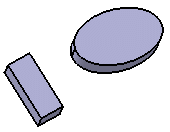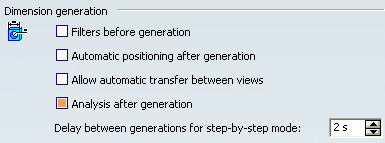Generation | ||
| ||
Update

- Disable automatic update when view is created
- Select this check box if you do not want the view to be updated automatically, when it is created. In this case, the created view is seen as not up-to-date.
To update the view, use the Update command or run the Update Drawing batch.
 By default,
this option is not selected.
By default,
this option is not selected. - Disable automatic updates when view is modified
Select this check box if you do not want the view to be updated automatically, when it is modified. Once its specifications (properties, breakout, clipping, section...) are modified, a view is seen as not up-to-date.
To update the view, use the Update command or run the Update Drawing batch.
 By default,
this option is not selected.
By default,
this option is not selected.
![]()
View

- Exact preview for view generation
Select this check box if you want an exact preview when generating views. Note that exact previews show exactly what will be projected. In this case, the 3D representation will be loaded in Design mode when previewing the view to generate, even if you are working in Visualization mode.
Clear this check box to get a quick preview of the 3D representation when generating views. Note that quick previews do not necessarily show what will be projected, but show exactly what is visualized in 3D. In this case, a 3D shape or product open in Visualization mode will not be loaded in Design mode for the preview, which optimizes memory consumption.
 By default,
this option is selected.
By default,
this option is selected.- Propagation of broken and breakout specifications
- Select this check box if you want broken and breakout specifications
to be reproduced when creating views.
Important: - Broken specifications are not propagated to detail views.
- Breakout specifications are not propagated to section views.
 By default,
this option is not selected.
By default,
this option is not selected. - Auxiliary and section views orientation according to profile
- Select this check box if you want auxiliary and section views to be oriented according to
the profile. In this case, the X axis will be parallel to the
profile.
Important: - Be aware that this setting is a default value, i.e. the setting used when creating the view is stored by the view and cannot be edited via the view's properties (available via ).
- This setting drives the angle of the view in the sheet. So if the auxiliary/section view profile is modified, the view rotation angle will be modified accordingly.
 By default,
this option is not selected.
By default,
this option is not selected. - View axis system based on 3D axis system
- Select this check box if you want the axis system of the generated
view to be based on the axis system of the 3D shape. This enables
you to create views with the same orientation if, when creating two
views in the same projection plane by selecting two different
faces, the axis systems which are specific to these faces are
different.
For example, take the following 3D shape:Important: The view projection plane is not defined by the selected face, but, in all cases, by the absolute plane which is closer to the orientation of the selected face (XY, YZ or ZX). This is the reason why you may end up, in some cases, with a view that looks like an isometric view. 
With the View axis system based on 3D axis system option cleared, the view orientation will be different depending on the element selected in the 3D when creating the view, as shown in the table below.If the View axis system based on 3D axis system option is cleared... then the view orientation is as follows: and if a face of the rectangular pad is selected, 
and if a face of the elliptic pad is selected, 
and if the absolute XY plane is selected, 
With the View axis system based on 3D axis system option selected, the view orientation will always be the same, no matter what element is selected in the 3D when creating the view.
If the View axis system based on 3D axis system option is selected... then the view orientation is always as follows: and if either a face of the rectangular pad, a face of the elliptic pad, or the absolute XY plane is selected, 
 By default,
this option is not selected.
By default,
this option is not selected.
![]()
Generated geometry

- Preserve modifications applied to graphical properties
- Select this option if you want the graphical modifications you
apply to generated geometry to be preserved when the view is
updated.
 By default,
this option is selected.
By default,
this option is selected.
![]()
Dimension generation
Generated dimensions are positioned according to the most representative views. In other words, a dimension will appear on a view so that it does not need to be created on another view.
The dimensions are generated on the views on the condition the settings were previously switched to the dimension generation option.

- Filters before generation
-
Select this check box to display the Dimension Generation Filters dialog box before generation. This enables you to specify what type of dimensions you want to generate. Also, in assembly or product views, this lets you indicate what 3D shapes you want to generate dimensions for.
 By default,
this option is not selected.
By default,
this option is not selected. - Automatic positioning after generation
-
Select this check box if you want the dimensions to be automatically positioned after generation.
 By default,
this option is not selected.
By default,
this option is not selected. - Allow automatic transfer between views
-
Select this check box if you want dimensions to be automatically transferred to the most appropriate view when regenerating dimensions.
 By default,
this option is not selected.
By default,
this option is not selected. - Analysis after generation
-
Select this check box to display the Generated Dimension Analysis dialog box after generation.
 By default,
this option is selected.
By default,
this option is selected. - Delay between generations for step-by-step mode
-
Specify the delay between each dimension generation when generating dimensions step by step.
 By default,
this option is set to 2 seconds.
By default,
this option is set to 2 seconds.
![]()
Balloon generation

- Creation of a balloon for each instance of a product
-
Select this check box if you want a balloon to be generated for each instance of a component: therefore, if a component is used two times within a product, then the balloon will be generated twice. If you leave this box unselected, a single balloon will be generated for all instances of the same component, when a component is used several times within a 3D representation.
 By default,
this option is not selected.
By default,
this option is not selected.